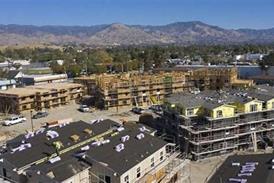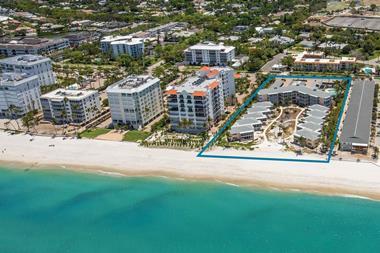UK house price growth and tight supply good news for private rented sector, writes Russell Handy
UK house price growth – up 11% year-on-year according to Nationwide – is running ahead of an economic recovery and has stirred observers and sector specialists in recent weeks. Institutional investors in the private rented sector (PRS) – the “holy grail” as Hermes Real Estate chief executive Chris Taylor called it this week – could stand to benefit from a slowdown or cooling measures.
This week, the European Commission urged Westminster to take action. In its annual review, the EC said UK authorities should monitor house prices and be ready to deploy appropriate measures to address “excessive” house price rises and increases in mortgage indebtedness in the £5trn (€6.9trn) asset class.
“There is ample scope for PRS to become a significant institutional investment sector”
Nick Mansley
Are cooling measures really needed? And if so, what does the UK have in its macro-economic toolbox?
“The EC thinks we should introduce cooling measures, but the options are relatively limited in terms of their effect and have a limited chance of success,” Savills director of residential research, Lucian Cook told attendees at an annual Financing Property presentation in London this week. “The housing market is driven by equity so that limits the impact of using macro-economic tools to cool the market.”
Cook outlined a number of options for the sector – ranging from curtailing equity loans to reducing mortgage guarantees, to enforcing the mortgage market review.
Interest rate rises could calm the sector. Hermes for example, foresees a potential 0.25% interest rate rise later this year. But what Cook calls the “nuclear option” – of increasing rates sooner than expected – is not a solution due to a lack of economic recovery beyond London.
And therein lies the issue for the residential sector and by extension PRS. The IPF last year noted that a shortage of housing in London and the south east was ”a serious issue”. Concerns regarding overheating are greatest in the UK capital and, despite Cook’s assessment that house price growth is now spreading beyond London’s fringes to the south east, the rest of country is experiencing modest growth, or, as First Property calls it, a “ripple effect” to regional secondary markets. The company’s annual results, released this week, highlight the esteem in which residential property is now held, with office to residential conversion a key strategy following UK government changes to planning rules. For investors, accessing quantity of stock is an issue, as chief executive Ben Habib has previously pointed out.
An issue of supply rather than a bubble?
Geography suggests the UK is not in a bubble. Cook said only a combination of “over-exuberant house-price growth” and increasing mortgage rates would create a bubble, while Nationwide says the government’s Help to Buy scheme has only had a limited impact, playing a “supporting rather than starring role”.
For investment consultants Towers Watson, “tight, inelastic” supply is the reason London is experiencing rising prices but is not leading the rest of the UK into a housing bubble. In its recent Global Markets Overview report, the consultancy identifies a “structural problem with low supply”, estimating that around 240,000 housing units need to be built over the next 20 years.
Supply concerns are echoed by the EC in its review which, despite acknowledging that delivery of new properties has risen, notes that new housing construction remains low and has fallen short of demand by a “considerable margin”.
“A shortage of supply has long been a structural phenomenon and is likely to extend into the medium term,” the EC said. “Action is needed to further boost the supply of houses.”
Cook agrees. “Fundamentally, we need to build a lot more houses – but that takes an awful long time,” he said.
A new report from Mill Group, ‘Inflation Matching Characteristics of Mixed Tenure Private Housing’ (see RELATED FILES) by academic and consultant Nick Mansley and Mill Group CEO David Toplas, foresees “suppressed housing demand”.
The report says that in the event of “shocks”, there are a number of automatic stabilisers to ensure rental growth maintains its link with inflation. Rents, the report says, rise in line or ahead of inflation – a big draw for institutions considering the PRS sector.
In a Private Rented Sector 2010 report, the UK Treasury outlined the need to ensure a strong “supply-side response” to support the UK’s economic recovery. The sub-sector was identified as having a key role to play in how well the wider residential sector responds to changing demand. The level of investment by both individuals and institutions would, it said, “be crucial”.
Institutional activity so far
Speaking at the British Property Federation’s annual conference this week, Orion Capital Managers founding partner, Aref Lahham said PRS is yet to attract significant international capital. He said: “There’s been a lot of talk about institutions investing more but it hasn’t happened in any big way in the UK.”
Fellow panellist Ken Wong, chief operating officer of Related Companies, said it would be some time before international investors felt comfortable with UK PRS and for the sector to establish itself. “It may take some time for capital to trust the systems here,” he said.
Dr Jacqui Daly, who produces Savills’ Rental Britain report, said there is a “misconception that PRS is a new tenure”, adding that PRS has already attracted investment.
In March, the Mill Group launched its first PRS project in a joint venture with Bovis Homes. The pair agreed to buy 190 new-build homes in the south of the UK for £45m. Sigma Capital and Gatehouse Bank’s £700m joint venture has the potential to grow to 6,600 new rental homes from the partnership’s initial roll out of 2,000 properties. Legal & General Property is seeking to increase its exposure to the UK residential market over the long term, through both PRS and social housing. Those investing in PRS usually have one target audience in mind – young, professionals not on the housing ladder in large cities.
In the same month, an Abu Dhabi Investment Authority (ADIA) vehicle committed £200m to PRS provider Fizzy, a subsidiary of Thames Valley Housing (TVH).
Invesco Real Estate made its first PRS investment on behalf of a UK local authority pension fund last month, spending £32.5m on the 118-unit, west London scheme due for completion in 2016. “PRS is a new sector for a lot of people and the most obvious choice is greater London,” John German, Invesco’s director of residential investments, told IP Real Estate, pointing to the fact that London has a higher proportion of rent-paying residents than the rest of the UK.
Speaking at the Investment Property Databank (IPD)’s launch of its residential index earlier this year, M&G Real Estate fund manager Alex Greaves said his enthusiasm had been limited to greater London’s residential sector, citing a lack of rental growth beyond. The investor, which last year spent £105m on a 534-unit residential portfolio, prefers inner London over central London when investing in residential. “We need to see wage growth in UK secondary cities,” Greaves said.
Mansley, who accepts that “affordability pressures” are particularly acute in London and the southeast, is a strong believer in the potential of PRS to thrive beyond the capital.
Invesco, will consider non-London locations, according to German. “It’s about the overall benefits of regional exposure where yields may be higher but rental income lower,” he said.
Affluent cities such as Cambridge and Oxford, where house prices are closer to those found in the UK capital, may have more appeal to PRS investors than northern cities, where banks’ loan-to-income caps could have less effect on first-time buyers. But Savills, Daly said, estimates that in Manchester, the number of households renting doubled between 2001 and 2011.
Both in London and beyond, wage growth, as Greaves points out, remains an issue. But the Mill Group’s report finds that despite wage growth easing, rents have still kept pace with inflation. Returning economic growth and expected increases in the rate of wage growth could result in above inflation rental growth.
Time will tell if PRS pays off
For those investing, there is also the risk that “one bad tweet” from a disgruntled tenant to the chief executive of a PRS provider or investor could cause reputational damage. With the UK approaching a general election, the political outlook could also impact the wider residential sector in 2015. Responding in January last year to a government paper on PRS, the IPF said rent controls and additional security of tenure provisions would rapidly destroy potential for institutions to invest in PRS.
PRS is about more than simply identifying places where first-time buyers cannot afford. Those who observe and monitor the UK residential sector maintain that there is a need for more rented property.
Mansley believes that the share of housing in owner occupation has been falling in recent years and cites a number of reasons that UK PRS is now here to stay.
“A lack of housing, demographic changes, increased student numbers, professionals and others moving to the UK – as well as people moving around the UK – have all created demand for renting,” he said. “There is ample scope for PRS to become a significant institutional investment sector.”
As well as constrained supply, the PRS sector could also benefit from tighter lending rules from the UK’s major banks. Lloyds Banking Group and RBS have recently clamped down on mortgage lending, enforcing loan-to-income caps on top of existing affordability checks. Bad news, it would seem, for first-time buyers, but a plus point for PRS.
Only time will tell if the rationale pays off for investors in UK PRS, a sub-sector seemingly born out of the longest and deepest recession the UK has endured. Some argue that investment decisions have been made in the last six years, suggesting that PRS could be a post-recessionary blip, conceived at a time when many potential homebuyers were locked out of the market.
At M&G Real Estate, Greaves disagrees, pointing to a coming together of strong rental growth, increased population of urban areas and less supply.
For Hermes, which is now evaluating the case for investing in UK PRS, having done so in New York, the sector needs to offer reasonable long-term returns. Taylor, who this week said urbanisation was ”paying dividends” for the firm, is cautious on PRS, citing management cost “leakages”.
The UK might slowly move towards a more US-style multi-family residential model. It could be some time, however, before tenants, as one observer put it, move freely around the country within one major PRS bran








![Invesco Real Estate [Europe]](https://d15duu1h3gsd2d.cloudfront.net/Pictures/100x67fitpad[255]-90/P/Pictures/web/o/w/c/invesco_global_logo_blue_pos_rgb_682811.jpg)














No comments yet